Page
7: Xi Scorpii - Delta Herculis
|
|
|
OBJECT: Xi Scorpii
|
TELESCOPE: Meade 10"
f/10 SCT |
| DATE: 06.28.1996 |
TIME: 12:53 am EDT |
| TRANSPARENCY: Fair |
SEEING: Good |
| MAGNIFICATION: 179x |
LOCATION: Vicksburg, MI |
| COMMENTS: This one
appears to be a "Double Double" like Epsilon Lyrae. The brightest
star is yellow in color, while its dimmer companion appears orange when
viewed out of focus. The double to the south has two stars equal
in magnitude with no color. |
|
| OBJECT: Struve 1999 |
TELESCOPE:
Meade 10" f/10 SCT |
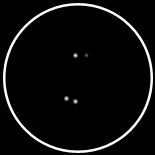
|
| DATE: 05.10.1997 |
TIME: 10:34 pm EDT |
| TRANSPARENCY: Good |
SEEING: Fair |
| MAGNIFICATION: 96x |
LOCATION: Schoolcraft,
MI |
| COMMENTS: This one is
another "Double Double". This pair of doubles has more variety in
magnitude than Epsilon Lyrae though. The northern most double
contains the brightest star. No color, but white, can be
distinguished under the present seeing conditions. |
|
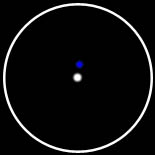
|
OBJECT: Beta Scorpii |
TELESCOPE:
Meade 10" f/10 SCT |
| DATE: 06.28.1996 |
TIME: 1:03 am EDT |
| TRANSPARENCY: Fair |
SEEING: Good |
| MAGNIFICATION: 179x |
LOCATION: Vicksburg, MI |
COMMENTS: The brilliant
primary is white. The secondary is half the magnitude of the
primary and blue in appearance when shifted out of focus.
|
|
| OBJECT: Kappa Herculis |
TELESCOPE:
Meade 10" f/10 SCT |
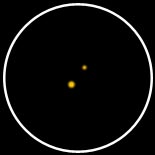
|
| DATE: 05.31.1996 |
TIME: 11:23 pm DT |
| TRANSPARENCY: Fair |
SEEING: Good |
| MAGNIFICATION: 96x |
LOCATION:
Kalamazoo Twp. |
| COMMENTS: Primary is a
"sharp" golden-yellow. Secondary is also yellow, but darker than
the primary. |
|
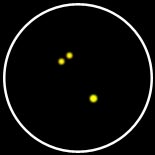
|
OBJECT: Nu Scorpii |
TELESCOPE:
Meade 10" f/10 SCT |
| DATE:
06.28.1996 |
TIME: 1:24 am EDT |
| TRANSPARENCY: Fair |
SEEING: Good |
| MAGNIFICATION: 156x |
LOCATION:
Vicksburg, MI |
| COMMENTS: The primary
star is bright yellow. The secondary, after closer examination,
was discovered to be a close binary system in its own right.
Color was difficult to distinguish, but seemed a dark yellow. |
|
| OBJECT: Sigma Coronae
Borealis |
TELESCOPE:
Meade 10" f/10 SCT |
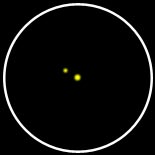
|
| DATE: 05.31.1996 |
TIME: 11:39 pm EDT |
| TRANSPARENCY:
Fair |
SEEING:
Good |
| MAGNIFICATION: 96x |
LOCATION: Kalamazoo
Twp. |
| COMMENTS: These two are
nearly identical in color; both are yellow. The primary is about
a magnitude brighter than the secondary. |
|

|
OBJECT: 16/17 Draconis |
TELESCOPE:
Meade 10" f/10 SCT |
| DATE: 05.31.1996 |
TIME: 11:55 pm EDT |
| TRANSPARENCY: Fair |
SEEING:
Good |
| MAGNIFICATION: 96x |
LOCATION:
Kalamazoo Twp. |
| COMMENTS: The two
brightest stars in the eyepiece are identical in magnitude.
However, 17 Draconis has a faint yellow companion. Very tricky! |
|
| OBJECT: Mu Draconis |
TELESCOPE:
Meade 10" f/10 SCT |
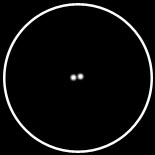
|
DATE: 06.28.1996
|
TIME: 1:34 am EDT |
| TRANSPARENCY:
Fair |
SEEING:
Good |
| MAGNIFICATION: 313x |
LOCATION:
Vicksburg, MI |
| COMMENTS: This is the
closest association I have observed thus far. The two are
absolutely equal in magnitude. They appear to be white. |
|
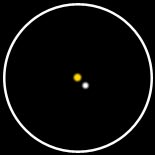
|
OBJECT: Alpha Herculis |
TELESCOPE:
Meade 10" f/10 SCT |
| DATE: 06.29.1996 |
TIME: 10:09 pm EDT |
| TRANSPARENCY:
Fair |
SEEING:
Fair |
| MAGNIFICATION: 746x |
LOCATION:
Nature Center |
| COMMENTS: The brightest
star of this pair is golden-yellow. At first glance it appeared
that the fainter companion was also yellow, but it took on a white hue
at higher magnifications. |
|
| OBJECT: Delta Herculis |
TELESCOPE:
Meade 10" f/10 SCT |

|
| DATE: 06.29.1996 |
TIME: 10:27 pm EDT |
| TRANSPARENCY:
Fair |
SEEING:
Fair |
| MAGNIFICATION: 192x |
LOCATION:
Nature Center |
| COMMENTS: The brilliant
primary star of this system is bright white. The faint companion
is either red or deep orange. It was difficult to tell under the
seeing conditions. |
[ 1 | 2 | 3 | 4 | 5 | 6 | 7 | 8 | 9 | 10 ]
|
![[Double Star Log]](Images/dslog.jpg)
![[Double Star Log]](Images/dslog.jpg)